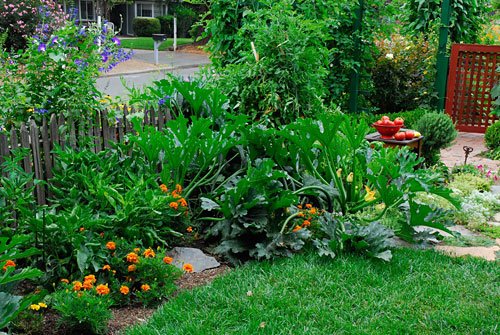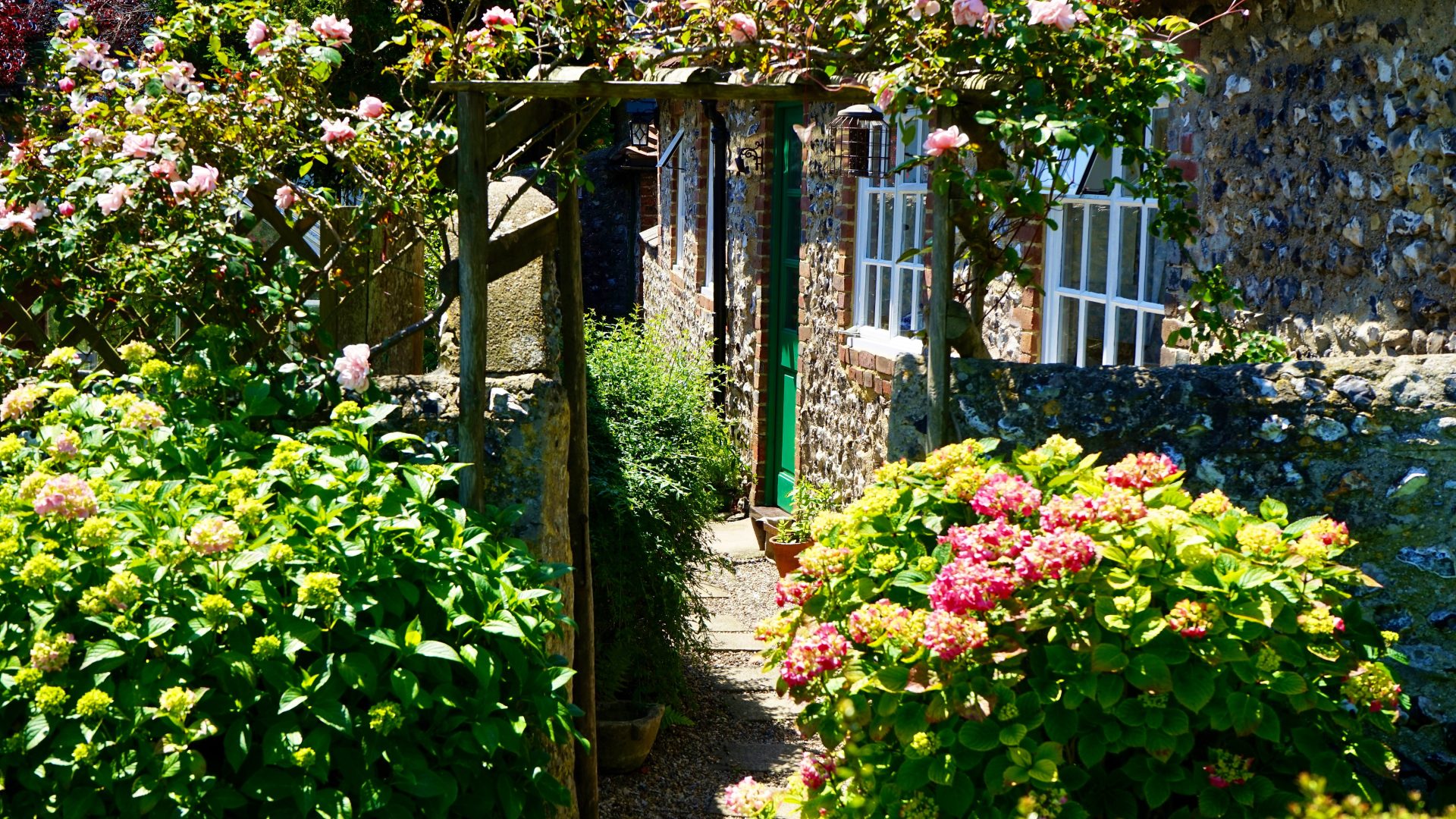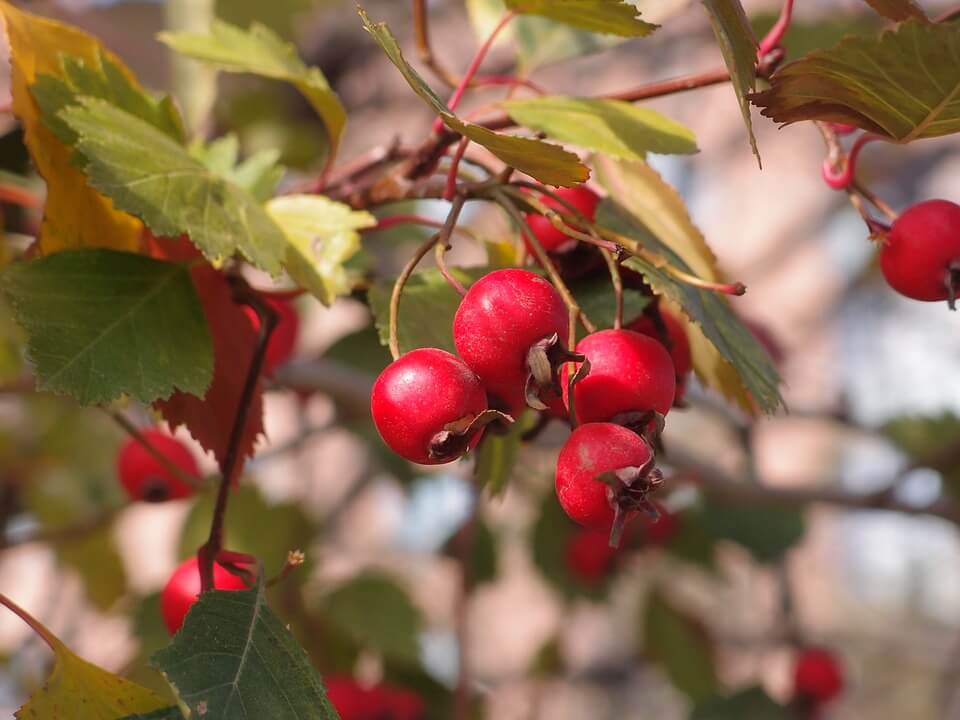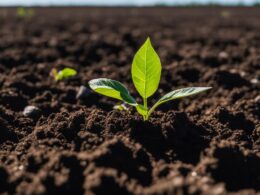Edible landscaping is a great way to make your yard truly unique. With the right plants, you can create a vibrant and delicious landscape that will provide you with fresh fruits, vegetables, and herbs all year round. In this article, you will learn about 15 of the best plants to create your own edible landscape. From blueberries to cherries, and from spinach to thyme, you’ll find everything you need to make your landscaping dreams come true. So let’s get started!
1. Blueberries
You can get a sweet, healthy treat with blueberries – they’re the perfect addition to your edible landscaping dreams! Blueberries are an easy addition to any garden, as they require minimal maintenance and are relatively hardy. Blueberry bushes are deciduous, so they will lose their leaves in the colder months, making them a great choice for climates with cold winters. Blueberries can be grown in a variety of soils, but they prefer slightly acidic soil. Blueberries can be planted in the ground or in a container, and will produce fruit for several years. Once established, blueberries can be harvested in the late summer and early fall. The fruits are delicious eaten fresh, or used to make jams, jellies, and pies. If you’re looking for a low-maintenance edible plant for your garden, blueberries are a great choice.
2. Strawberries
Strawberries are a delicious way to liven up any outdoor space! These tasty treats are easy to grow and can be used in many different ways in edible landscaping. Strawberries are a perennial plant, so they come back year after year and keep producing fruit for many years. They need plenty of sunlight, and they prefer acidic soil conditions. To get the best results, you should plant them in a raised bed and use mulch to retain moisture. You can also use companion planting with other plants to keep pests away and help improve the soil.
Strawberries are a great addition to any edible landscape. You can use them to create an eye-catching feature in your garden, or you can even incorporate them into a vegetable border or hedge. They also make a delicious addition to salads and desserts, and you can even make jams and jellies with them. With their bright red color and sweet flavor, strawberries are the perfect way to make your edible landscaping dreams come true.
3. Apples
Apples are a great way to add a splash of color to your outdoor space, offering a sweet flavor that can be enjoyed all year round. Apples can be grown in a variety of climates, from temperate to warmer regions, and come in a range of colors and sizes. They are easy to care for and can provide a great source of fruit for your family. Apples can be grown from seeds, grafted, or planted as a cutting. When planting your apple tree, be sure to give it plenty of sun, water, and nutrients. Additionally, it’s important to prune your apples to encourage healthy growth and the production of more fruit. With a little effort, you can have a beautiful apple tree in your edible landscape.
4. Peaches
Peaches are a delicious and vibrant addition to any garden, providing a juicy and sweet taste that can be enjoyed all summer long. Not only are they a tasty option for edible landscaping, but they are also easy to grow and maintain. Peaches require full sun, well-draining soil, and regular watering. They also prefer a slightly acidic soil to thrive, and may require additional fertilization. Pruning is also important to maintain the shape of the tree and to promote healthy growth. If you are looking for a fruit tree to add to your edible landscaping dreams, peaches are an excellent option. With the right care, they can provide you with a bounty of juicy, sweet peaches for many years to come.
5. Cherries
Cherries are a great option if you’re looking for a sweet, juicy fruit to add to your garden! While peaches are a popular choice for edible landscaping, cherries offer their own unique benefits. Not only are they juicy and flavorful, but they also come in a variety of colors and sizes. Depending on the variety you choose, you can get cherries ranging from bright red to deep purple. They also come in varying sizes, from large, sweet cherries to smaller, tart varieties. Cherries are a great addition to any edible landscape, with their bright colors and sweet flavor. Plus, they can be used in a variety of recipes, such as cherry pies, cobblers, and jams. They are also a great addition to salads and other dishes as a tasty garnish. With the right cherry varieties, you can achieve your edible landscaping dreams.
6. Tomatoes
Tomatoes are an incredibly versatile and delicious fruit that can be used in a variety of dishes and salads! Whether you’re looking for a sweet cherry tomato to add a kick of flavor to a salad or a large beefsteak tomato for a classic summertime BLT sandwich, there’s an option for everyone. Tomatoes are easy to grow and can be grown in pots, planters, or directly in the ground. Additionally, tomatoes are incredibly low maintenance and can thrive in full sun or partial shade environments. With the right combination of soil, water, and fertilizer, you can easily achieve a bumper crop of tomatoes in no time.
7. Carrots
Carrots are a sweet and flavorful vegetable that make a delicious treat for any occasion! Bursting with flavor, they are sure to bring a smile to anyone’s face. Carrots are an excellent choice for edible landscaping, as they are easy to grow and require very little maintenance. While they are usually associated with the classic orange variety, carrots can also come in a variety of colors, from yellow and purple to white and red. Carrots are also very nutritious, containing plenty of vitamins and minerals that are essential to a healthy diet. Furthermore, carrots are a great addition to salads, soups, and side dishes, providing a sweet and crunchy flavor to any meal. With their sweet taste and low maintenance requirements, carrots are the perfect choice for anyone looking to add a bit of flavor to their edible landscaping dreams.
8. Garlic
Garlic adds a delicious, savory flavor to any meal, and it’s a must-have for any meal. Garlic is relatively easy to grow, and can be grown in a variety of climates. It is a hardy perennial plant that can survive a wide range of temperatures. When planting garlic, it is important to select the right variety for your climate. It’s also important to choose a sunny spot for planting, which will help the garlic to grow to its full potential. Garlic can be planted in the spring or fall, and can be harvested in late summer or early fall. In addition to adding flavor to dishes, garlic also has many health benefits, including fighting off bacteria and viruses. Garlic is a great addition to any edible landscape, and can be used to add flavor and health benefits to any meal.
9. Potatoes
Potatoes are a must-have in any kitchen; they’re versatile, easy to prepare, and delicious! Whether boiled, mashed, or baked, potatoes are the perfect companion to any meal. They can also be used to add flavor to dishes such as soups, stews, and casseroles. When it comes to edible landscaping, potatoes are a great option for creating an attractive and productive garden. Planting potatoes in raised beds, containers, or directly in the ground, is a simple and efficient way to ensure a successful crop. With a wide variety of varieties to choose from, and the ability to store potatoes for up to 6 months, they are a great addition to any edible landscape.
10. Onions
Onions are a great way to add zest and flavor to your meals! They are a versatile vegetable, which can be harvested in many forms, from the typical white onion to green onions, red onions, and even sweet onions. Onions are easy to grow and require minimal maintenance, making them a great choice for those looking to create an edible landscape. They can be grown in a variety of ways, from planting the bulbs in the ground, to growing in raised beds or containers. Onions are also relatively easy to store, and can last for several months if stored properly.
Onions are a great addition to any garden, whether you’re looking to add color or flavor to your meals. They are also a great companion plant, helping to attract beneficial insects and repel pests from other plants. Onions are also an excellent source of nutrition, containing vitamins A, B, and C, as well as iron and calcium. With their distinct flavor and easy-to-grow nature, onions are a great way to add some zest to your edible landscaping dreams!
11. Lettuce
Moving away from onions, let’s take a look at another popular vegetable for edible landscaping: lettuce. Lettuce is a nutritious and fast-growing addition to your garden or landscape. It requires little maintenance and can provide a delicious harvest in as little as 30 days. Lettuce is also a great choice for edible landscaping because it comes in a variety of shapes, sizes, and colors, allowing you to create a stunning visual effect in your yard. Lettuce can be grown in containers or in indoor gardens as well as directly in the ground, making it one of the most versatile vegetables for edible landscaping.
It is also important to note that lettuce prefers cooler temperatures and should be planted in the spring or fall. Lettuce thrives in full sun, but can also tolerate some shade. It is important to make sure the soil is well-drained and fertilized, as lettuce is a heavy feeder. Additionally, it is important to keep lettuce well-watered and to regularly harvest the leaves as they become mature. With a little effort, you can have a beautiful and abundant supply of lettuce for your edible landscaping needs.
12. Spinach
Adding a pop of color and nutrition to your garden, spinach is a great choice for edible landscaping. This leafy green vegetable can be planted in early spring or late fall, and it is a great choice for both small and large gardens. Spinach grows best in cool weather and is relatively easy to care for. It requires regular watering and thrives in soil that is rich in organic matter. Planting spinach in an area of your garden that receives partial shade will help keep it from getting too hot in the summer months. In addition, spinach can be harvested multiple times during the growing season, so you will have a steady supply of fresh and nutritious greens for the entire season.
13. Basil
Growing basil in your garden is an easy way to add flavor to your dishes! Basil is an easy-to-grow annual herb that can be grown in large containers, raised beds, or directly in the ground. It grows quickly and can be harvested several times throughout the growing season. It also produces an abundance of fragrant leaves that are used to flavor a variety of dishes. Basil can be used fresh or dried to add flavor to salads, pesto, sauces, and even desserts.
Basil is also known for its health benefits. It is packed with vitamins A, C, and K, as well as minerals like iron, magnesium, and calcium. It is also a great source of antioxidants and can help reduce inflammation and improve overall health. Adding this fragrant herb to your edible landscape is a great way to increase your intake of healthy vitamins and minerals. With its easy growth and flavorful leaves, basil is an excellent choice for adding flavor and nutrition to your dishes.
14. Oregano
Moving on from basil, oregano is another delicious and versatile herb that is perfect for edible landscaping. This hardy perennial is native to the Mediterranean region, but is now grown around the world. Oregano is a low maintenance plant that is relatively easy to grow. It prefers hot, sunny locations and does not need much water, making it an ideal choice for those who desire a low maintenance edible garden. The herb is frequently used in Italian and Greek cuisine, adding a distinctive flavor and aroma to dishes. Oregano is a great choice for anyone looking to incorporate herbs into their edible landscaping plans. The herb is very hardy and will tolerate most climates, provided it gets enough sunshine and water. Additionally, oregano is an attractive plant, featuring an abundance of fragrant, gray-green leaves and tiny white flowers. Its beautiful foliage and bright flowers make it a great addition to any edible garden.
Can Apples from Edible Landscaping be Used for the Tasty Recipes?
Apples from edible landscaping can undoubtedly be used for tasty homemade apple recipes. Whether you’re baking a classic apple pie, making a refreshing apple salad, or crafting a mouthwatering applesauce, these perfectly ripened fruits will elevate the flavors and textures of your dishes.
15. Thyme
Thyme is an easy-to-grow herb that’s perfect for spicing up your garden and adding fragrant flavor to your dishes. It’s an easy-to-care-for perennial that doesn’t require much maintenance and can be grown in a wide range of climates and soil types. Thyme has a long history and has been used medicinally, as well as in cooking and as an ornamental plant. The leaves can be harvested to make an aromatic tea, and it’s a great addition to salads, soups, and stews. It’s also a great companion plant, as it helps repel insects and can be used to attract bees and butterflies to your garden. Thyme can be planted indoors or outdoors, and is a great choice for an edible landscape. It has a long blooming season and will provide you with a steady supply of fresh herbs throughout the season. With a little care, it can become a treasured part of your garden for years to come.
Frequently Asked Questions
What is the best soil type for planting edible landscaping?
The best soil type for planting edible landscaping is a nutrient-rich, well-draining soil. It should have a pH balance of 6 to 7.5, and should contain organic matter like compost or peat moss to help retain moisture and provide essential nutrients.
Are there any specific climate requirements for the listed plants?
No, there are no specific climate requirements for the plants. However, some may do better in different climates than others.
What type of maintenance is required for edible landscaping?
Maintenance for edible landscaping typically includes weeding, watering, pruning, fertilizing, and pest control.
Is there a recommended fertilizer to use for edible landscaping?
No, there is no one-size-fits-all fertilizer for edible landscaping. It’s best to consult with a local expert to find the right fertilizer for your plants.
What pests or diseases should be monitored for when growing edible landscaping?
When growing edible landscaping, it’s important to monitor for pests and diseases such as aphids, cucumber beetles, and powdery mildew. These can all cause damage to plants, so it’s important to take preventative measures.
Conclusion
Edible landscaping is a great way to bring beauty and health to your outdoor space. With the right plants, you can enjoy fresh, delicious, and nutritious fruits and vegetables grown in your own backyard. Blueberries, strawberries, apples, peaches, and cherries are all great options for fruit trees. Herbs like spinach, basil, oregano, and thyme are also a great addition to your edible garden. With these 15 plants, you’ll be able to create the edible garden of your dreams. So get started today and enjoy the bounty of fresh fruits and vegetables you can now harvest from your own yard!









